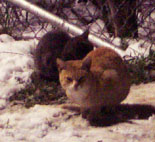
Chip & Cairo 1/11/03, the extra-snowy winter. They were trapped later in the year & are now nice & warm at CR!FR.
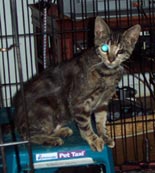
Siren 11/02. The vet said her eye had not been injured & she may have lost it due to infection when she was a tiny kitten.

Some of the Annandale cats keeping an eye on me as I set humane traps. 3/03
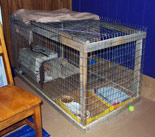 Alfie in his
homemade crate.
Alfie in his
homemade crate.
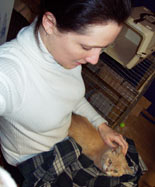 Taming Alfie.
Taming Alfie.
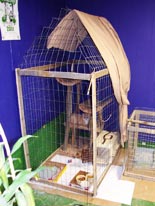 Alfie in
the deluxe "cat cabin", built with rudimentary skills & simple
items.
Alfie in
the deluxe "cat cabin", built with rudimentary skills & simple
items.

 Wily
mama calico, still at large
Wily
mama calico, still at large
BACKGROUND - TAME - CRATE -
RESTSTOP PHOTOS 1, 2
A special aspect of CATS RULE! Feline Rescue is our Feral Outreach effort. Many rescues & sancturaries can't or won't accept ferals, many vets won't treat them, they generally don't make great pets; they are really the most forsaken of needy cats. Many of the cats at CR!FR are former ferals or born to former ferals.
Fortunately, most of the once timid & fearful cats are now relaxed, some are even friendly. Even the ones that are still very shy are happy among their big CR!FR tribe. They play with toys and other cats, watch birds from the window & lounge lazily amid a snuggle of snoozing kitties on a bale of straw.
BACKGROUND
CR!FR's humble origins began when I encountered a colony
of cats at a reststop on the NJ Turnpike
back in Aug, 2002. Even though they were
4 hours from my house, I decided to help those cats.
I read Alley Cat Allies' informative site "cover to cover" & assembled the necessary supplies. I purchased a Hav-a-hart raccoon trap at Home Depot & borrowed several traps from a trapper in D.C. We returned to the reststop in Oct. & trapped 5 cats! One was in rough shape; gaunt, patchy fur & with a bad eye that looked injured. One was a feisty kitten who thrashed around like a maniac in the trap. The other three were adult males; 2 smallish & one large fellow.
Over the next three months we trapped at the reststop 4 more times & trapped 5 more cats. I built several wood frame & wire mesh crates to hold them until their vet appointments. Everyone got spayed/neutered, vaccinations, ears cleaned, parasite control, de-wormed, and other ailments treated. Almost everyone had a URTI (upper respiratory tract infection). There were dental problems, skin problems, etc. but no serious conditions or injuries.
Each time we trapped we had less success than the time before. There were still at least 12 cats at the reststop. Mike convinced me to seek help from someone, perhaps a local rescue group, who was closer.
Luckily, my call for help was answered by an amazing friend of felines extraordinaire named Mary. She helped us immensely by taking over the trapping at the reststop, which wasn't very close to her house either. She trapped & had spayed/neutered 8 cats for us!
Meanwhile, I got a request from a concerned lady named Dorothy in nearby Annandale to help with the colony in the woods behind her house. Over about a year, she & I trapped & spayed/neutered 16 cats, including 2 litters. Some were semi-tame as Dorothy fed them each day & they grew used to her.
I trapped a very feral cat at the Chesapeake Reststop on I-95. She had 6 kittens before her spay appointment. An Annandale cat also had 4 kittens before her vet visit. I also accepted a litter of 5 & their very feral mama who were found in a neighbor's shed.
While CR!FR fully supports the use of TNR to address the crisis of feral cat overpopulation & management of feral colonies, it was difficult to return the cats we'd trapped, had spayed/neutered & cared for. After returning the first 3 males to the reststop, we worried about them & came to regret putting them out in the trash-strewn woods on that rainy day in November. We decided to keep as many future rescued ferals as we could.
Those ferals are family now & won't be put back out in the wild. We feel all cats deserve a safe, warm, dry, loving home & while it's understood there aren't enough homes for even tame friendly cats, we want to be able to offer a happy home to all who cross our path. Mary re-trapped one of the 3, who is still with us. Sadly, the other 2 haven't been seen since.
CR!FR would like to expand our rescue & care capabilities to help/TNR more feral cats & help reduce deaths in shelters by taking animals slated for "euthanasia".
TAMING FERAL KITTENS
Young
kittens up to 3 months of age are generally easier to tame. A quiet,
safe room
of
their
own,
lots
of gentle
handling & loving
attention will usually do it over several days, weeks or months.
Kittens love to play, of course, & a dangling string will rivet
their attention & often relax
their fears.
Initially, though, they are likely to be quite frightened & can do some damage if not handled carefully & with necessary protective measures. It's a good idea to gently wrap the kitten in a thick towel while handling it until it knows you're not a threat & is more at ease.
Kittens over 3 Months of Age
Older kittens take more time.
Alfie, Pebble & Siren were
about 5-6 mos old & extremely
frightened when they first came to CR!FR. They were housed
in training crates with a carrier for hiding in. They wouldn't come
out of the carrier
& would hiss & growl & swipe at my hand at mealtime.
At least twice a day, I lifted the carrier out with the door closed, set it on the crate, & bungeed the carrier to the crate. With heavy leather work gloves on, I put my hand in & endured the swipes & bites from the frightened cat. I soon began to touch the cat gently to accustom it to the feeling of contact. Of course, they hated that but I persisted. I spoke softly to the cat in reassuring & friendly tones so they'd get used to my voice.
Then I began gently pulling the resistant cat out of the carrier & enveloped it in a thick towel so it could be held without struggling or scratching. They didn't like that either but with several sessions of this each day they soon learned that I wasn't a threat & they relaxed a bit. Soon they would sit on the towel on my lap, relaxed & enjoying a good ear/cheek rub (I found even the most nervous cat usually enjoys a good ear rub). Eventually, I could hold them without the towel. I kept them crated for a while so I could continue to handle them; otherwise they'd hide in a cranny somewhere hard to get & forget we were buddies.
Siren in particular is now a fabulous sweetie who loves attention. She's a super-affectionate lap cat, quite a long way from the hissing, spitting, slashing bundle of fear she once was. Pebble has recently discovered all on her own the benefits of friendship with humans, mainly vigorous ear rubs & neck scritches. Now she seeks out contact instead of recoiling & even sits in your lap for a good cuddle. Alfie was friendly for a while but after a few trips to the vet over the years, he decided not to trust me & declined my offers of friendship.
ADULT FERAL CATS
Many
people say feral cats can't be tamed; granted, most probably can't.
However, given the chance, many ferals can be socialized, although
it can take quite a long time. I was able to "tame"
2 of our most timid wild ferals & it took less than a year. They're
not cuddly housecats but they're great company & good friends to
the other cats.
Basically, it takes a quiet, stable environment & a lot of patience. Whenever I move through the cat areas (all indoors/enclosed), I talk to them steadily in positive & friendly tones. I never move suddenly & I avoid eye contact with the timid cats. Before long, the cats begin to associate me with dinner & that's nothing to run from. They soon tolerate my presence better & don't run & hide when they hear me coming. They'll watch me from a safe vantage point & some will remain in their cat nest without leaping up & hiding.
A great way to coax timid ferals from their hiding places is to bring some sliced cheese & toss little pieces to everyone. Many ferals will want to know what the strange tasty things are that everyone's running for. Also, even timid ferals are fascinated by moving strings & playing with the friendlier cats is a great way to get their attention. The ferals will emerge from hiding to get a closer look, if not to join in.
Eventually, they may be gathering around the food bowl with the other cats when you're dishing out dinner. They may tentatively sniff your extended hand. You may be able to touch them a bit, especially when they're eating or snoozing. The cats that show interest or curiosity are the best bets for "taming". Some never will get over their fear & mistrust.
To hasten these techniques, it's good idea to eliminate the feral cats' hiding place. It sounds heartless to take away a cat's security zone, but the more they see you out in the open the sooner they'll realize you are not out to harm them. Give them tall cat trees & deep cat beds to nestle into but hiding lairs don't help your cause.
Keep subtly pushing the friendly olive branch toward the feral with potential & you may end up with a love monger who just needed encouragement to let the affection flow. Or you may have a friendlier more relaxed feral. Either way, it's a wonderful experience to gain the trust & friendship of a once-frightened animal. Best of luck!
USING A CRATE
We all remain concerned about ferals after they're returned to their
wild home after spay/neuter. In particular, the females, as spaying
is major
surgery, & cats with illness such as upper respiratory infection,
because it's unkown if they have any difficulties recovering after
they're put back out. It takes little space to keep a few
dog crates & hold the cats for at least a few days & make sure
they're ok before they go back, especially if it's during a cold season.
You can also mix anti-biotics into their food to treat illness for
7-10 days.
To get the feral cat into a carrier to return it once it's recovered, simply set up the carrier in the crate as a hiding box when you first introduce the cat to the crate. When you're ready to take the cat out of the crate, it will already be in the carrier hiding out (bungee the door open & bungee the carrier to the back & side of the crate, so the cat doesn't burrow behind it instead of going into it).
If the cat is behind or on top of the carrier, slowly & quietly move the carrier so the opening is facing the cat & try to encourage the cat to go in. Wearing leather welding gloves is a good idea to protect yourself from a frightened cat. Or you could wrap a towel around your arm a few times,

